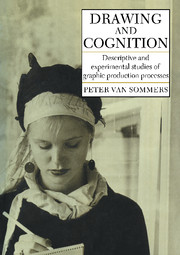Book contents
- Frontmatter
- Contents
- Preface
- 1 Basic executive constraints in drawing
- 2 Maintaining paper contact, anchoring, and planning
- 3 The reproduction of rectilinear figures
- 4 The production of curvilinear forms
- 5 The impact of meaning on executive strategies
- 6 Simple representational drawing
- 7 Difficult graphic tasks: A failure in perceptual analysis?
- 8 Stability and evolution in children's drawings
- 9 Innovations, primitives, contour, and space in children's drawings
- 10 Children's repeated drawings: How are innovations coded?
- 11 The pragmatics of everyday graphic production
- References
- Index
7 - Difficult graphic tasks: A failure in perceptual analysis?
Published online by Cambridge University Press: 07 October 2011
- Frontmatter
- Contents
- Preface
- 1 Basic executive constraints in drawing
- 2 Maintaining paper contact, anchoring, and planning
- 3 The reproduction of rectilinear figures
- 4 The production of curvilinear forms
- 5 The impact of meaning on executive strategies
- 6 Simple representational drawing
- 7 Difficult graphic tasks: A failure in perceptual analysis?
- 8 Stability and evolution in children's drawings
- 9 Innovations, primitives, contour, and space in children's drawings
- 10 Children's repeated drawings: How are innovations coded?
- 11 The pragmatics of everyday graphic production
- References
- Index
Summary
It is never easy to prove in any graphic context that a failure in performance is due directly to a failure in perceptual analysis. There will always be a storage stage, however brief, between attending and acting during which information may be lost or distorted. Even when people are copying, they are continually switching backward and forward from inspecting the model to monitoring their own performance, and when the model is removed before drawing, as it is in many of these studies, storage must necessarily intervene.
Building a case for defective perceptual analysis in drawing is not made any easier by the ability of subjects to recognize relatively accurately designs that they cannot draw. Even when working from memory, they can usually select the design they are attempting to produce from a set of distractors in an “identity parade,” even when the distractors are more like the model than their own completed versions. Subjects may fail to copy a design when given generous time to inspect it, yet it is inconceivable that they would fail to recognize differences between the model and even quite subtle variants of it under such inspection conditions.
Why then raise the issue of defective perceptual analysis as a serious issue? The first reason is that there seems to be evidence from the nature of errors in drawing and copying that something associated with perception is often involved.
- Type
- Chapter
- Information
- Drawing and CognitionDescriptive and Experimental Studies of Graphic Production Processes, pp. 131 - 160Publisher: Cambridge University PressPrint publication year: 1984



